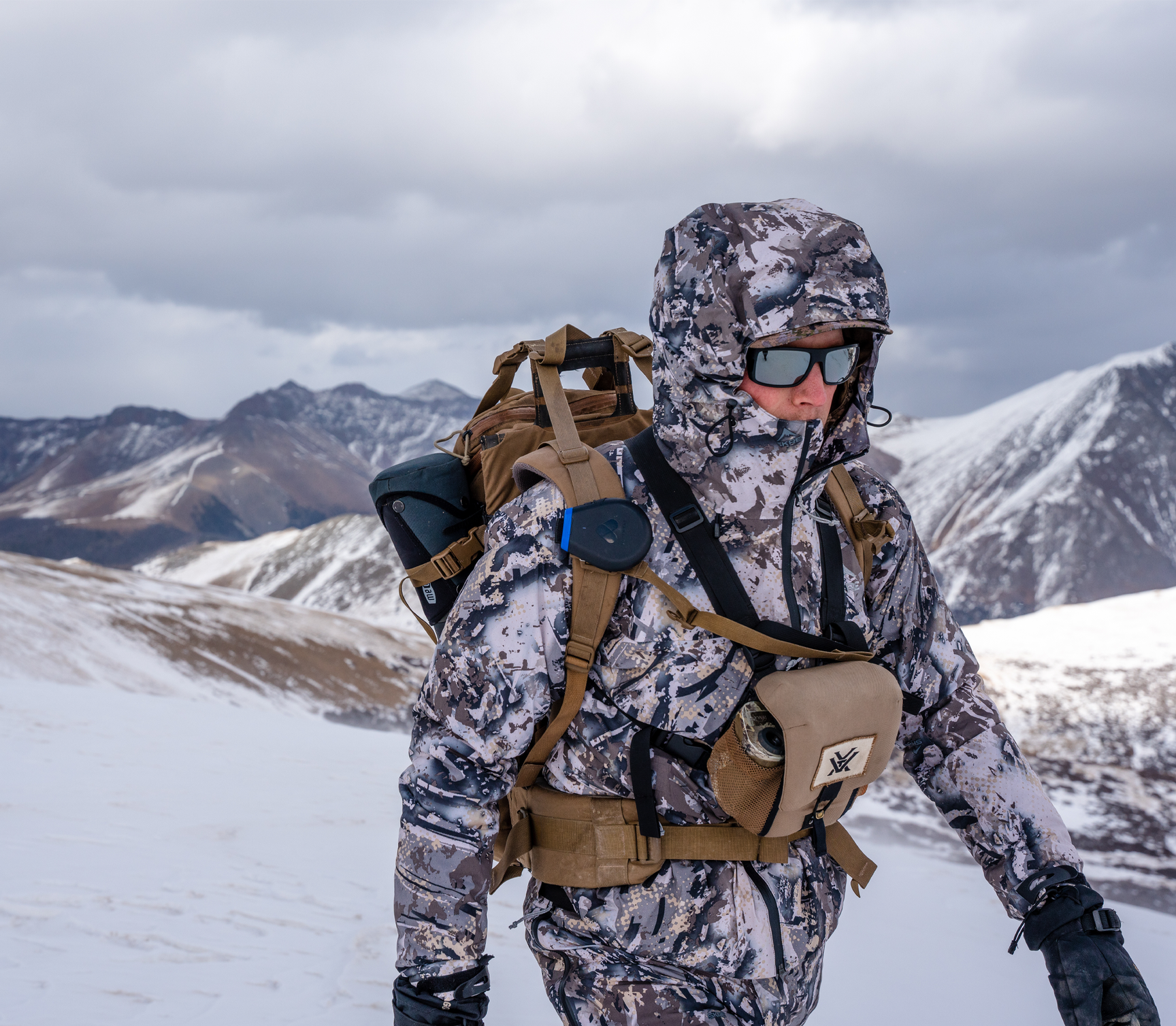A Guide to Base Layers: How to Layer Clothes for Cold Weather Hunting
Jan 12, 2023
The coldest temperature ever recorded was -128.6 degrees Fahrenheit. While you won't likely face this cold temperature when out hunting, it will still get pretty cold. This is why it is important to know how to layer your base layers for hunting in the cold.
If you don't know how to dress for the weather, you might have to cut your hunting trip short because of the cold. But where should you start?
Get The Best Base Layers for Cold Weather Hunting
An essential part of any cold weather hunting gear is a high quality base layer. SKRE Gear® offers a variety of base layers to choose from to help you stay comfortable during the entirety of your hunt.
Shop All Base Layers
Why Layering Works
You might be wondering why you should bother with a layering system. Isn't it easier to throw on a coat or two and call it a day? Not at all.
Many people layer their cold weather hunting clothes wrong. This leads to them having an uncomfortable experience. You might be used to putting on several layers of flannel and maybe a heavy coat. You might then suffer from getting drenched in sweat and being bombarded by the cold wind. You might feel heavy and fatigued too.
That's because some layers of clothes are horrible for cold weather. They will weigh you down, hold onto excess moisture, and make you uncomfortable. Using proper layers is not a waste of money or time.
There is a reason why all the best hunters layer their clothes in a specific way. Hikers, skiers, and other people who spend time in cold weather follow the same layering science. This is because layering works, but only if you do it right.
How Layering Works

Each layer works with the other layers. This is why layering is so efficient. Your outer layer will work with the middle layer to keep the wind from hitting the core of your body.
Using the base, middle, and outer layers works for a reason. The middle layer works in conjunction with your base layer to wick away moisture.
Suppose you start sweating. The base layer will start to wick away that moisture from your body. The middle layer comes in contact with the base layer. This brings the moisture further from your body so that you stay dry and warm, versus sitting in your cold sweat all day.
They also keep you from getting overheated. Your base and middle layers work together to keep your sweat in check.
The layers will also work in reverse to keep external water like snow or rain from hitting your body as well.
Base Layers Are The Foundation
You can think of this layering system as the foundation for your house. If there is a crack in your foundation, there is a chance that your house could collapse. If your base or middle layers have a problem, your outer layer isn't going to do much to help it. This will result in you being cold, wet, and uncomfortable when out on your hunting trip.
Using the wrong clothes can make you go home early and in a bad mood. You'll last far longer outside with the right clothes. This makes it easier to stay out and hunt elusive animals without being interrupted.
High quality hunting gear should be designed to last. And while you should think of your hunting clothes as a long-term investment, these layers don't have to break the bank. There are plenty of options that can fit into any price range. This makes it easy to get the clothes you need.
What Is the Best Base Layer for Hunting?
The base layer is the innermost part of your cold weather hunting gear. Many people don't think that a base layer is necessary. They instead go out with a mid and outer layer. But this will cause you to get too cold too fast. A good base layer is your foundation. It is similar to the insulating fat that many winter animals have.
It is an extra layer of protection to keep you warm. Your base layer for cold weather also has the unique ability to wick away moisture. This is important because people may sweat in cold weather. This could make you extra cold once the sweat cools down. But if the sweat is wicked away, you won't have this problem. This will allow you to stay outside for much longer.
Some base layer shirts may come with a hood for extra protection. You can also get socks and scarves or wraps to add some additional warmth. But for most hunting excursions, you will need at least some base layer pants and a shirt.

Base Layer Materials
There are many different materials you can choose for your base layer.
Merino wool is one of the most popular. It is very warm and wicks away moisture. It also keeps you from overheating.
Polyester is another great material. It is famous for how lightweight and breathable it is. It is also less expensive than merino wool and other options.
Silk is another good option. It will keep you warm all day. The downside is that silk is not great at keeping water away. A bonus is that it dries quickly. So, if you do get soaked, you won't have to worry about it for long.
Polypropylene also dries quickly, wicks away moisture, and is great at keeping you warm. It is also very durable, so it should last you several years.
One material that you should never use is cotton. Many people make this mistake, especially those who have never bought hunting clothes or hunting gear before. Cotton is a heavy material that absorbs water and does not dry quickly. This will make you feel heavy, cold, and uncomfortable.
Get The Best Base Layers for Cold Weather Hunting
An essential part of any cold weather hunting gear is a high quality base layer. SKRE Gear® offers a variety of base layers to choose from to help you stay comfortable during the entirety of your hunt.
Shop All Base Layers
What Is The Best Mid Layer For Hunting?
While choosing a base layer is important, choosing a middle layer is important too. You shouldn't go straight from your base layer to your outer layer. Your middle layer is essential for keeping you warm.
There are a few misconceptions about middle layers. Many people think that this layer consists of big, fluffy clothes like parkas. This is not true. If you put clothes like that in your middle layer, you will overheat. You will also be very heavy and it will be hard for you to move.
The middle layer focuses on clothes that are warm yet also breathable and lightweight. It should be similar to your base layer but just a little bit thicker and warmer.
Mid-Layer Fabric Options
Merino wool and polyester are still good choices for the middle layer. These materials will continue to keep you warm and light. They will also wick any moisture you come in contact with. This is important if it starts snowing or raining. You don't want any cold water reaching your core. You can get hypothermia if that happens.
Fleece is another good material option for your middle layer. Fleece is famous for being very warm and lightweight. Fleece is typically used more often on days where it isn't extremely cold. It used to be made of real wool from sheep, but synthetic variants are used today. They still offer the same quality of warmth too.
The main downside is that fleece may absorb water. Some synthetic types are better at avoiding this. But most types of fleece are not as good as wicking away water as merino wool or polyester.
You should opt for heavier items for cold days, but not too heavy. This is why merino wool is such a great option. It is able to keep your body warm, but is not as heavy as some other materials like cotton. This will keep you lightweight and mobile when you're out hunting. This is important because no one likes to be weighed down or slowed down by their clothes.
How to Choose the Right Outer Layer for Hunting

Your outer layer is like having a protective shell around you. Your outer layer is bulkier than the middle and base layers. This is necessary to prevent wind and moisture from cutting into your deeper layers.
Having a good outer layer will make it harder for the elements to penetrate your deeper layers. Consider a waterproof jacket to start. If it rains, snows, or if you fall into some water, this coat will help you. It will let the water roll off of its surface and keep it from reaching your inner layers.
The jacket should also be resistant to the wind. The wind is colder and harsher than you might expect. Winter wind can cut through almost anything. It can be hard to function once the core of your body gets cold.
Our Nebo Rain Gear is a great outer layer. Not only are they resistant to rain, but they are great wind breakers as well. It is breathable and not too bulky, making it perfect for almost any hunting excursion.
What You Need to Know
You need to make sure that your outer layers are as comfortable as possible. If your outer layers are too tight or uncomfortable, it will be hard to focus on your hunting duties. The layer may also not protect you as much as you need it to if it doesn't fit properly. Trying on the clothes before you buy them can help.
If you can't try the clothes on or if you're buying online, don't forget to choose the right size. Remember to think about the extra bulk the middle and base layers will give you. Your outer layer should be looser than the previous two layers. This will give you plenty of room to move around.
Many people think that big, bulky coats will make them invincible against the cold. But this is not always true. If you don't have an outer layer that is resistant to the elements as well as fits well, these bulky outer layers will only slow you down.
It is best to stick with clothes that are warm yet lightweight. Durability is also important. You don't want your outer layer to fall apart after a few uses. Get something that will last for several years.
Look for coats with special features like vents. Vents are great for maintaining your body temperature. They save you time because you won't have to take off your coat to cool down.
Make sure you have pants for your outer layer too. You don't want your legs getting cold when you're out in the wilderness. Properly putting on all these layers should keep you very warm and protected.
Get The Best Base Layers for Cold Weather Hunting
An essential part of any cold weather hunting gear is a high quality base layer. SKRE Gear® offers a variety of base layers to choose from to help you stay comfortable during the entirety of your hunt.
Shop All Base Layers
Essential Cold Weather Accessories
Most people focus on keeping their chest and legs warm. But there are other parts of your body you need to keep warm too.
Head Coverings
Your head loses a lot of body heat. You'll get very cold very fast if you don't have something to cover it. The main options are a hooded jacket, beanie, or balaclava.
A hood is nice because it covers the back of your neck as well as your head. You can get base and middle layers with hoods too. This adds to the amount of warmth you can retain.
The problem with hoods is that they may not stay put. This is especially true if they are too large or too small. They may keep slipping off of your head. This can get in the way when you're in the middle of an intense hunt.
You can avoid this problem by opting for a beanie instead. Beanie can be made of many different materials. Merino wool remains the classic choice. It will keep your head warm without making you feel overheated. It will wick away moisture from your heat too.
If you are looking for something that combines the benefits of both a beanie and a hood, you may want to look into a balaclava or a neck gaiter. These are nice because they provide coverage for the head, ears, and back of the neck without sacrificing fit.
Hands

The two choices to keep your hands warm is gloves or mittens. Gloves have individual spaces for your fingers. Mittens do not. There are different types of gloves and mittens depending on the level of cold protection that you need.
One reservation that hunters have about choosing mittens over gloves is the dexterity. They worry that they won't be able to pull the trigger or would have a hard time manipulating optics or even buttons on their clothing. Skre took this into consideration when they were designing the Bridger Glassing mitt. With a separate space for your index finger and goat leather palms, you still maintain a large amount of dexterity without sacrificing comfort from extreme cold.
Feet
Don't forget about keeping your feet warm. Walking through the snow or cold, damp soil can cool your feet down fast. You may want to look into gaiters if you are planning on being in deeper snow or higher brush. Gaiters go over the top of your boots and pants to help keep moisture from getting into your boots from the top.
Merino wool socks are great base layer for your feet! They grip your feet in a way that keeps your feet from sliding around in your shoes. They also keep your feet dry in case they start to sweat. If snow or water gets in your shoes, the socks should help wick them away too.
Layering for Different Types of Hunting
Changing your layering strategy for different types of hunting can give you an advantage. Some types of hunting occur in different months of the year. Some types also will expose you to certain weather or environmental conditions. Being prepared will make it easier for you to hunt.
Waterfowl Hunting
Consider waterfowl hunting. This type of hunting is known for being a chilly sport. You will be around cool water for most of it. You might accidentally step into puddles and so on. Make sure you have on your warmest layers and waterproof gear when hunting waterfowl.
Start with merino wool socks. These will keep your feet warm and dry when the ground around you is soaked and muddy. Going for an all-merino system may help you when hunting waterfowl.
This is because merino wool will keep your body dry in these wet conditions. You can start with a merino wool base layer followed by a wool middle layer. The outer layer is more variable.
Tree Stand Hunting

Tree stand hunting doesn't require much movement. You will mostly be sitting for hours at a time. This makes it even more crucial to dress warmly. Because you aren't exerting much physical effort, it is easier for your core temperature to drop.
Since you don't need as much mobility for spotting and stalking, you can get away with wearing hunting clothes that are a little bulkier.
Choose layers that you won't need to switch over the hours. Switching layers is noisy and can scare away the animals.
Spot And Stalk Hunting

Spot-and-stalk hunting requires a more specific layering system. You need to be ready for hours of sitting as well as long periods of hiking and staling.
Choose lightweight hunting clothes that are warm. Moisture-wicking fabric is important since you will likely start to sweat. Avoid bulky layers as they will get in your way and slow you down. And make sure your layers are quiet too. You don't want to be wearing noisy hunting clothes that will give away your position.
Your Guide to Base Layers
While it takes teamwork between all your layers to keep you comfortable and warm when you are out in the cold weather, we feel that base layers are the vital piece to the puzzle. Don't skimp on purchasing a cheap base layer - invest in your comfort and purchase a high quality base layer for your hunting gear. We promise you won't regret it!



